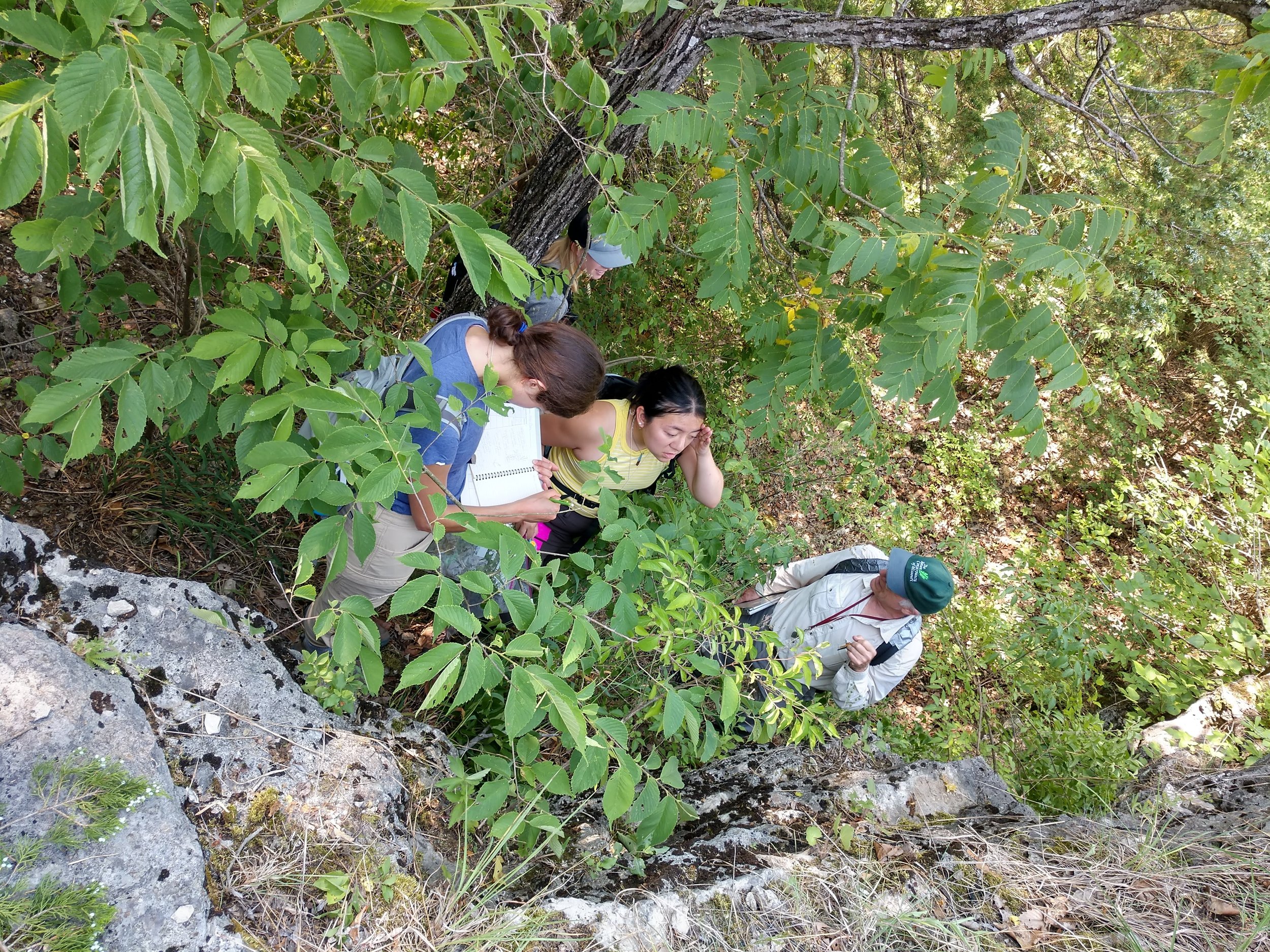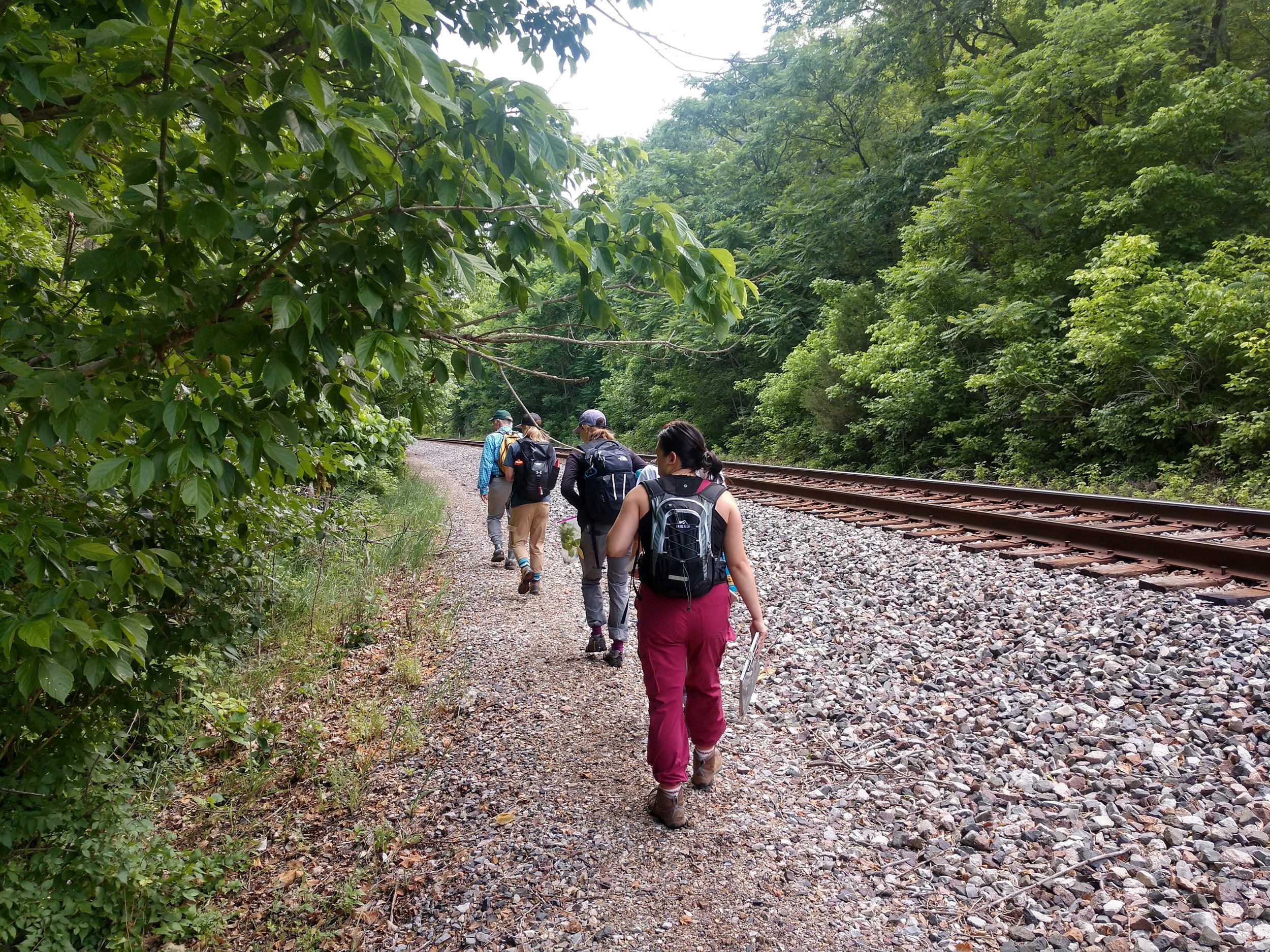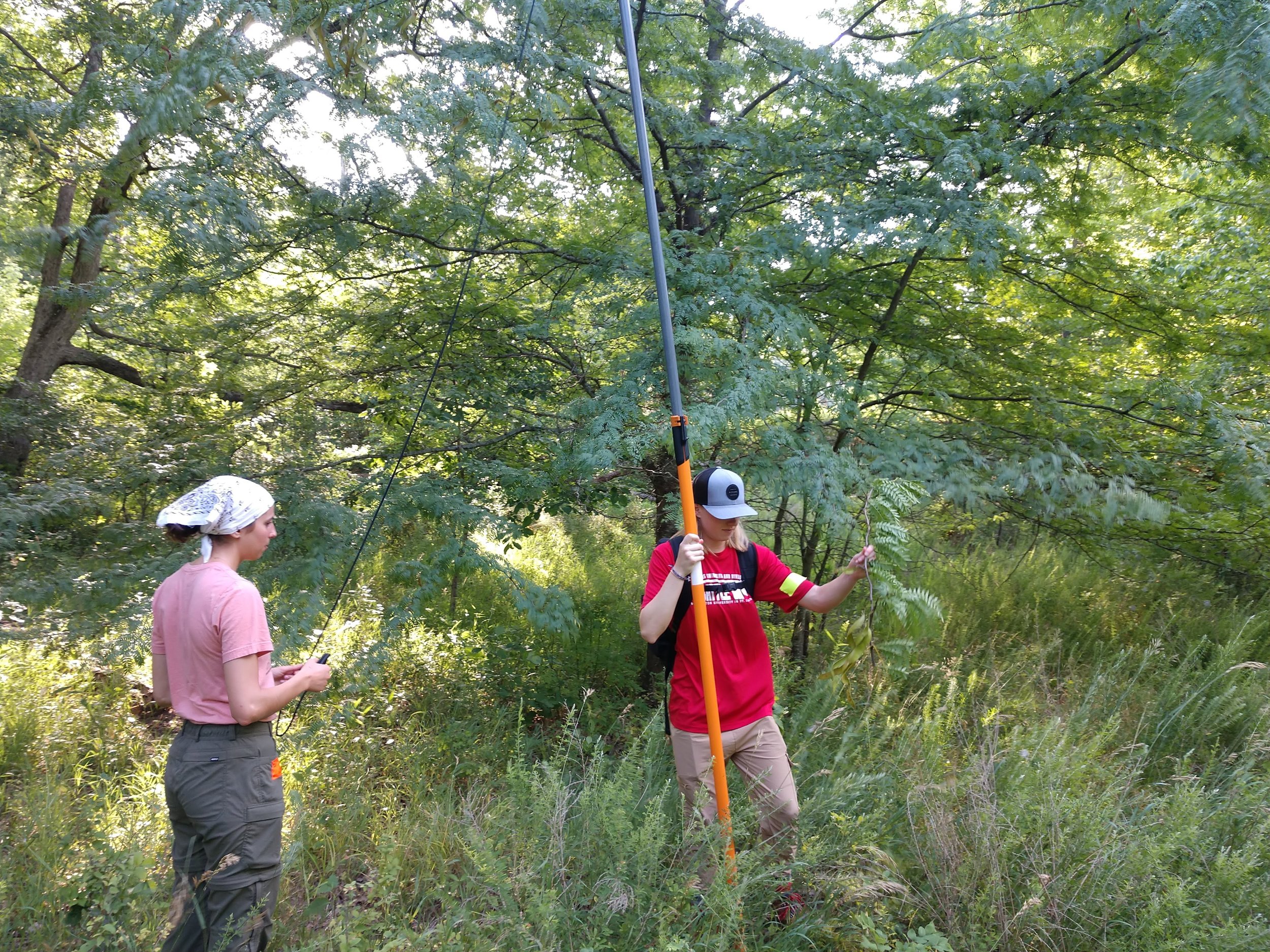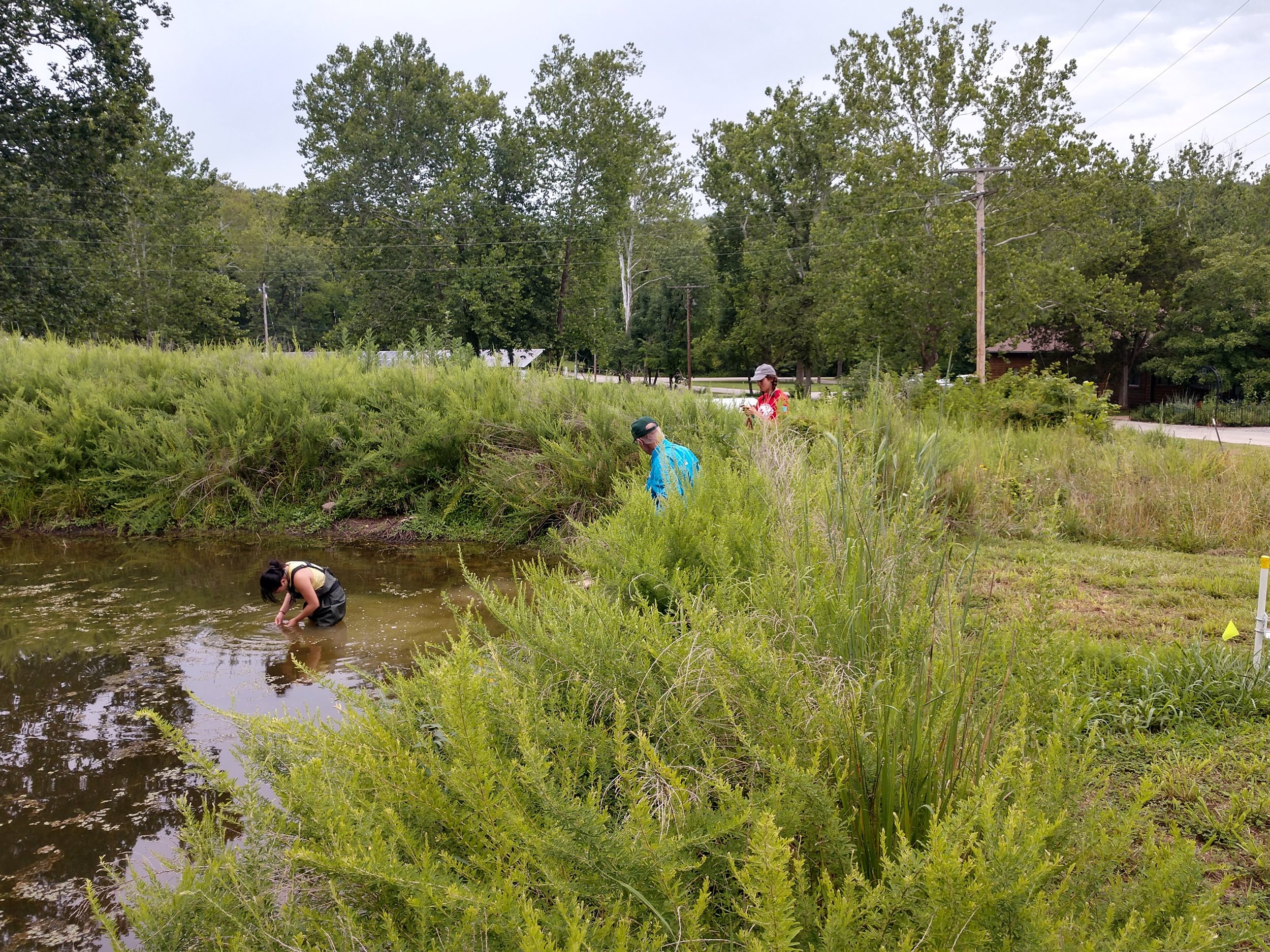Mar 19, 2024
Turn a New Leaf (600 Times): Flora of Tyson Project Catalogs Plant Biodiversity
A Tyson scientist collecting plants as a side project during research outings. A WashU professor sticking specimens in his backpack while teaching classes out in the field. These were the informal beginnings to a lofty new endeavor: to document and preserve a physical representative of every plant species growing across Tyson Research Center’s 2,000 acres.
Flora of Tyson co-Principal Investigators Erin O’Connell (l) and Doug Ladd
The Flora of Tyson Project began early in 2023 with the initial work of Erin O’Connell, Tyson Research and Conservation Project Coordinator, and Doug Ladd, former Director of Conservation of The Nature Conservancy’s Missouri Chapter and currently Senior Lecturer of WashU classes including Field Methods for Environmental Science and Applied Conservation Biology. Over the summer the two co-PIs expanded the team to include four undergraduate research fellows, all new to the field but equipped with, according to Doug, “lots of potential,” “great motivation,” and “an usually sophisticated ability to make superb herbarium specimens.” With that, “Team Flora” was set to explore the biodiversity of Tyson - and to find meaning for these plants far beyond the research center gates.
From Bunker to Botanical Garden
An undertaking of this magnitude is not conceived without reason. As Doug puts it, the Flora of Tyson Project was a long time coming, critical to both the field station’s ecosystem health and its environmental research efforts.
“If you’re a long-term ecological research center,” he explained, “you have to have basic information about the building blocks of your ecosystems, for multiple reasons. One, you can use this information to assess future changes. If there are significant declines, it gives you a warning signal. It’s also extremely useful to researchers - either current researchers or ones contemplating ecological research activities at Tyson - to have a laundry list to know what plants they’re dealing with. For instance, there is a globally significant forest ecosystem monitoring plot there that Dr. Jonathan Myers is running. It’s helpful for those crews to have a list of all the trees that are known to occur at Tyson. They’ve had to sort of create that from scratch themselves, but having this inventory as a tool really narrows down the possible universe of plants which confront researchers to begin with. It can tell them whether they want to focus a research activity or how to tailor it at Tyson.”
In theory, the project’s mission statement is simple: document every plant species at Tyson and preserve a physical sample of each. While the current project is not the first of its kind to be conducted on Tyson property, it is significant in its all-encompassing scope and methodical attention to detail. Past researchers had made lists of plants found at Tyson, including a master’s thesis from 1969, but they were exactly that: lists. None had vouchers of physical plants attached to them, meaning they could not be entirely trusted and were difficult to compare through a history of changes in botanical nomenclature.
A plant sample collected and preserved by Jane Walker at Tyson in 1999 is now part of the permanent herbarium collection at the Missouri Botanical Garden.
These preserved plant samples, Erin said, are stored in facilities called herbariums and act as “...a physical reference point. If someone says, ‘I saw white oak the other day in such and such a place,’ and the next person says, ‘Really? You saw white oak in that place? Are you sure? I’ve never seen one there.’ It’s not necessarily that one person is right or wrong; I don’t want to frame this as being all about resolving disagreement. But if someone was presenting information you would ask them to cite sources, right? It’s a similar concept - you can cite an actual physical reference, even without visiting that place yourself.”
Tyson did historically have an herbarium of its own, consisting of metal cabinets in an underground bunker with a few hundred plants inside, preserved and mounted. Unfortunately, the lack of mildew prevention and climate control in the bunker damaged the plants over time. Nevertheless, Erin put a hopeful spin on Tyson’s outdated records and lists, noting that the documentation at least offered a starting point - an indication of what Team Flora could expect to find over their 10 weeks of field work.
“That list at the start of the summer was around 700 species,” she said. “It’s more than I expected, let’s put it that way. The state of Missouri has 3,000 species, 2,000 native and 1,000 introduced. 700 species is about a third to a fourth of all the species in Missouri, which is of course a lot bigger than Tyson. So that’s pretty neat, that we might have so much diversity here.”
Before the team could even begin their formal inventory process, however, they needed to find a new place to properly store their plant samples. Fortunately a partnership was born with the Missouri Botanical Garden. As a research associate with MBG, Doug proposed that Tyson’s collected samples be added to the botanical garden’s own herbarium, the 2nd largest collection in North America, with 7 million specimens spread across its two buildings. Through this setup, Team Flora’s specimens are permanently archived in a world-class facility, available for future DNA analysis or morphological work, and digitally processed so researchers all over the world have access to high-resolution images. In weekly visits to MBG, the undergraduate fellows also got the chance to learn about the operations of a botanical garden and job shadow different professionals there.
Doug summed up, “The benefit to the Garden is they have the specimens and the database information long-term. The benefit to the students is they had an unparalleled experience and immersion into an entire research facility that most of the world doesn’t even know about. And the benefit to WashU is they get resource management information and baselines that will be permanently archived through the global capacities of the botanical garden.”
Exploring Ecosystems
How does one go about tracking hundreds of plant species across an entire environmental field station in the first place?
“Easy peasy,” Erin joked. “It’s only 2,000 acres, which is about three square miles!”
The first step was training the team, which Doug described as two-pronged. “One is the pragmatic aspects of how to navigate in this terrain, how to read topographic maps, things like that. The other is a basic crash course in plant science and field botany to be able to know what you need to look for in the field, which includes a lot of informal walking around and testing and talking.” Or, as Erin put it, “learning plants” and “learning how to learn plants.”
Doug Ladd (l) explaining sample collection techniques to undergraduate fellows (l to r) Clara Chavez-Ives, Eve Kearns, and Emma Diaz.
Whereas most of Tyson’s summer research teams learn lab protocols and the scientific method, Team Flora was jumping cognitive hurdles, figuring out how to rewire the very ways their eyes and brains take in the world around them. One crucial element was looking past the emerald blur that is Tyson Research Center during June and avoiding falling victim to “plant blindness” - the human tendency to see plants simply as green, without paying attention to the differences between them. Another element was tuning in to the feeling of familiarity. “You have to know what we’ve already collected and what we haven’t collected yet,” Erin said. “It meant constantly coming up to a plant and saying, ‘Have I seen this before?’” From there, the process of plant identification wasn’t simple either. Erin noted how the most obvious characteristics of plants are often the most variable and misleading - “You learn that the color of a flower is not always reliable, but instead the hairiness of the stem stays consistent within a species, for example.”
Animated map of Tyson Research Center showing the geolocations of Team Flora’s plant sampling efforts over 44 days during summer 2023. (Courtesy of Erin O’Connell)
Next came the question of how to traverse all of Tyson. At the beginning of the summer, Erin broke the 2,000 acres down into subsections with a plan to go to different zones on different days and cover them all from May to August. It quickly became clear, however, that certain areas of Tyson required more attention than others. While most of Tyson is covered by oak-hickory forest, ecosystems such as the exposed bedrock of Mincke Quarry and the wetlands around ponds required the team to spend extra time - “disproportionate to the size, but proportionate to the diversity” - cataloging the species there.
Plant phenology - the seasonal timing of their biological life cycles - also impacted the search. The team might visit a site in May and see new shoots poking out of the earth, only to have to return weeks later to give the growing plants a proper identification. For other species, the climate itself was working against them. The team aimed to collect plants when they were flowering or fruiting, as this stage is helpful and sometimes necessary for identification. However, as the hot summer of 2023 went on, the researchers realized a drought was interfering with plant phenology. Some species simply never flowered or fruited at all, despite evidence of their presence at Tyson.
“In the beginning of the summer it was just visiting as many ecosystems as we can find at Tyson,” Erin said. “And then it became more of a target list. For example, we haven’t collected this yet…where do we think we would find it? It was very exploratory. ‘If you see something weird, go look at it’ was the motto.”
“If you see something weird, go look at it.”
This motto did not just apply to vegetation, either. After identifying a new plant, the team would take a sample and make a voucher - a sheet containing the dried plant, information about its species and its collection, a verification stamp, and so on - to take to the Missouri Botanical Garden herbarium. While there, they delved into the archives and found just under 100 historical specimens taken from Tyson by researchers before them, some dating back to the early 1900s. For a group of botanical researchers, it was a gateway to historical “side adventures” across Tyson Research Center, a landscape which knew Indigenous peoples and 19th-century settlers long before it ever knew Washington University.
“I was never particularly interested in history,” admitted Erin, “but this project has gotten me thinking about what was happening at the time that mining towns were at Tyson. There was one time this summer where we found a record of Wisteria in a location where supposedly an old homestead was – one that I didn’t know existed. We spent a day looking, and we found foundation ruins of a homestead and a common garden plant that you wouldn’t expect to find at Tyson. Someone had likely planted it there in the early 1900s and it had run wild in that part of the forest. So there were some fun treasure hunt adventures too this summer.”
Members of Team Flora learning the process of permanently mounting a dried plant as a voucher specimen from a specialist at the Missouri Botanical Garden. (l to r: Sophia Crowley, Erin O’Connell, Emma Diaz)
Beyond treasure hunts, however, it is vitally important to situate the Flora of Tyson Project within a broader timeline. Scientists have engaged in herbarium studies since the 16th century, traveling to distant lands to document, collect, and inventory plants. It is a Eurocentric concept, Erin pointed out, and “...it pairs with colonialism a little stronger than we might feel comfortable with. Because people all around the world, of course, are knowledgeable about their native plants without the westernized approach to documenting biodiversity.”
Her statement evokes the struggle of local versus “professional” knowledge, of Western science versus the many other forms of inquiry that are no less real or valid. Understanding flora research and herbarium studies means also understanding that Western science as a whole is imbued with imperialist legacies. Thus, the Flora of Tyson Project has served as a lesson on multiple fronts, instilling within its team members the skills to identify plants and prepare vouchers, as well as the historical sensitivity needed to conduct such research.
Future of the Flora Project
The project is projected to continue into 2024. Some of this work will be administrative, tying up loose ends: finding plants that did not sprout this growing season, processing species and removing duplicates, finalizing the list into a living database. Doug also reported the possibility of a broader research publication, “Because it’s also an interesting question we’re dealing with - if you have a big block of habitat that’s been severely impacted by human activity and passively recovers over 70 years, what level of plant diversity are you likely to achieve? Tyson will be a significant case study for that information.”
While those numbers are not finalized, Doug predicts it could push well towards 800 different species of flowering plants and ferns alone. To find them all is no easy feat, but luckily Team Flora doesn’t seem to mind the challenge.
“There have been a couple times that we’re outside in a new ecosystem just looking around, and I’m like, wow, I’m at work right now,” Erin said. “This is normally what I do on my weekends, but I’m getting to do it professionally!”
About the author
Colleen McDermott is an undergraduate at Washington University in St. Louis studying environmental analysis and writing. They created Placemaking Tyson during summer 2022 and currently serve Tyson as Communications Associate.










